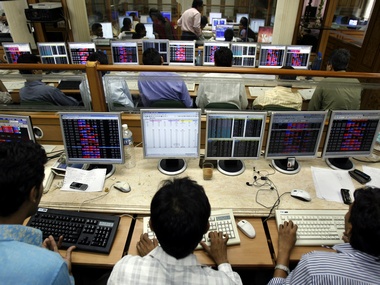The Indian market’s behaviour shows that text book economics has gone for a toss, once and for all. Otherwise, how do we explain the equity market’s 350 point surge on a day when the Reserve Bank of India raised policy rate by 25 bps? That too when the RBI’s action is contradictory too industry and market players’ demand for a rate cut.
Market observers attribute the rise in shares to cut in the marginal standing facility rate. MSF is the window banks access urgent funds. The RBI had, earlier in its bid to support the freely falling rupee, increased the cost of these funds by widen its spread with repo rate to 300 bps. Now this spread has been brought back to the normal level of 100 bps. The raising of the MSF rate had pushed up the short term rates in the system and thus corporates’ borrowing costs. So a cut in this rate will bring down their borrowing costs. This is the reason for euphoria in the market yesterday.
[caption id=“attachment_1140499” align=“alignleft” width=“380”]  The central bank may have realigned the spread between the MSF and repo rates, but the market today is significantly worse of that in July, when the RBI started its extraordinary steps to defend rupee. Reuters[/caption]
But is it that simple? It is not, says Mohan Shenoi of Kotak Mahindra Bank in a column in The Economic Times. The central bank may have realigned the spread between the MSF and repo rates, but the market today is significantly worse of that in July, when the RBI started its extraordinary steps to defend rupee.
The reason is that there are four key rates for the RBI now: the repo rate, the 7-day and 14-day term repo rate and the MSF rate. Any of these can assume the role of operative rate in the economy depending on the liquidity situation. This actually increases the uncertainty about the interest rate scenario.
Repo rate is the rate at which banks borrow funds from the RBI. This rate used to the policy rate (operative rate) until the central bank tinkered with the MSF rate to curb speculation on the rupee. Once the MSF rate got changed, unwittingly it became the operative rate and significance of the repo rate diminished. The RBI’s yesterday’s action has not helped much to bring the repo rate back into the reckoning. This is because the RBI also said the extraordinary measures that it had taken to support the rupee will not be wound back until exchange rate stability returns or until the rupee holds ground against the dollar.
And what about the rupee? Has it found anything to fall back upon? The simple answer is no.
As Shenoi puts it, FII outflows from the debt are continuing. We are blissfully unaware of it because equity market flows are on the rise. According to a PTI report, Overseas investors have pumped in more than Rs 12,100 crore or $1.97 billion in Indian equities since the beginning of this month amid easing concerns over the US tapering.
Moreover, dollar demand from oil companies is not yet reflected in the market. This is because the RBI has a special swap window open for this. It will shut it only gradually. The central bank also has a special dollar swap arrangement with banks to encourage them get dollar deposits. But this will come to an end by the end of November. So the dollar inflow through such swap arrangements will stop in the near future. The RBI has got about $11 billion until now via these swaps.
And last but not the least, is the US tapering. Once the Fed starts unwinding its bond buying programme, the FIIs will pull out their dollar funds from India in hoards to invest it there. A reviving US economy is always better than a sputtering Indian economy for them.
Are there ways for the government to arrest the outflows in such a situation? Yes there are.
The government should devise ways to cut the seven bars, mentioned by Kumar Kunal Kundu of Societe Generale in a BS column recently, to release the Indian tiger.
These are:
* Boosting power supply and rationalising power tariffs
* Optimising the use of natural resources
* Streamlining administrative procedures
* The ability to leverage favourable demographics
* Ensuring steady fiscal consolidation
* Building a single flexible domestic market and,
* Reduction of policy uncertainties to boost investment
As long these impediments stay, nobody can hope to get meaningful return from their investments in India. You cannot expect an actual recovery in the rupee and the economic weakness will continue.
However, the market may continue its happy gallop as long as money is in abundance with foreign investors.


)
)
)
)
)
)
)
)
)



